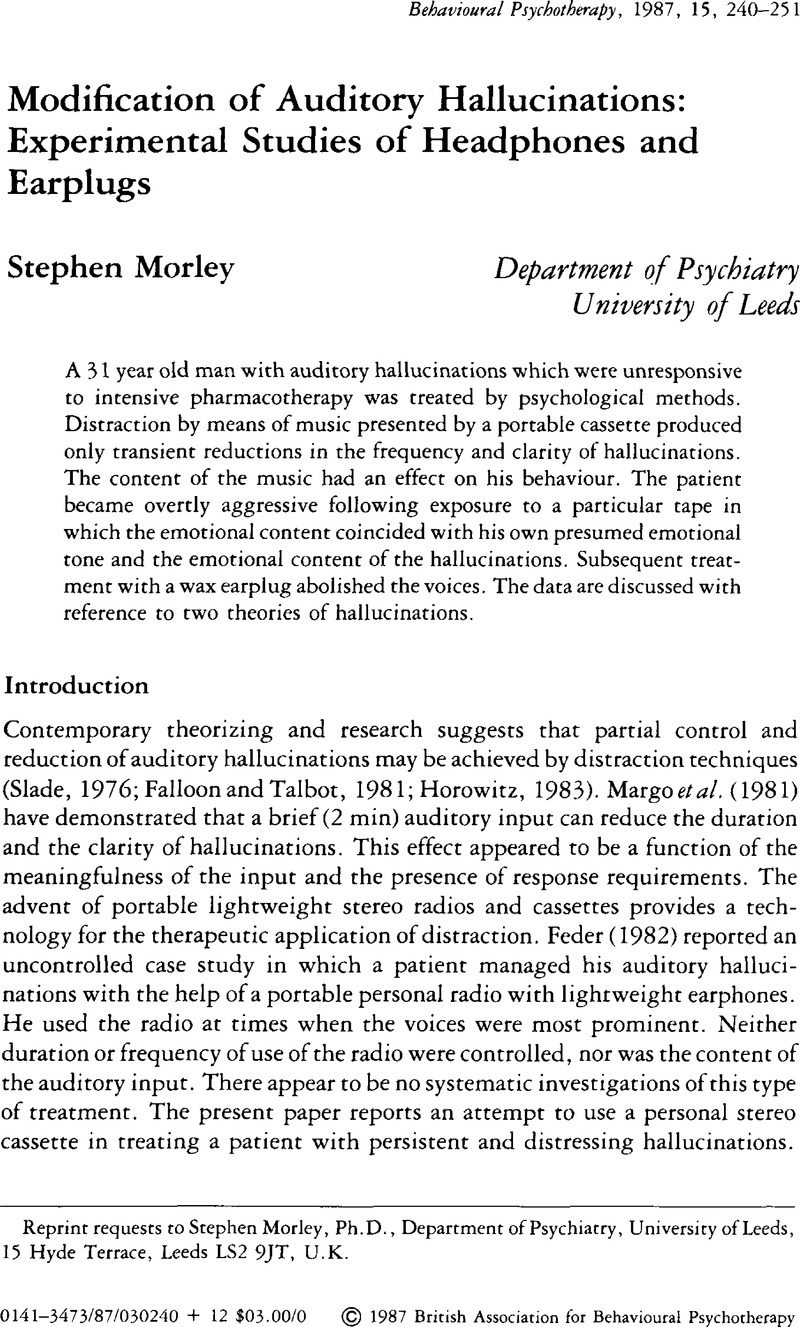Crossref Citations
This article has been cited by the following publications. This list is generated based on data provided by Crossref.
Collins, M. N.
Cull, C. A.
and
Sireling, L.
1989.
Pilot study of treatment of persistent auditory hallucinations by modified auditory input..
BMJ,
Vol. 299,
Issue. 6696,
p.
431.
Marks, David F.
1989.
Bibliography of Research Utilizing the Vividness of Visual Imagery Questionnaire.
Perceptual and Motor Skills,
Vol. 69,
Issue. 3-1,
p.
707.
McInnis, Melvin
and
Marks, Isaac
1990.
Audiotape Therapy for Persistent Auditory Hallucinations.
British Journal of Psychiatry,
Vol. 157,
Issue. 6,
p.
913.
Hustig, Harry H.
Tran, Dong B.
Hafner, R. Julian
and
Miller, Robyn J.
1990.
The Effect of Headphone Music on Persistent Auditory Hallucinations.
Behavioural and Cognitive Psychotherapy,
Vol. 18,
Issue. 4,
p.
273.
Tarrier, Nicholas
Beckett, Richard
Harwood, Sue
Baker, Amanda
Yusupoff, Lawrence
and
Ugarteburu, Itziar
1993.
A Trial of Two Cognitive-Behavioural Methods of Treating Drug-Resistant Residual Psychotic Symptoms in Schizophrenic Patients: I. Outcome.
British Journal of Psychiatry,
Vol. 162,
Issue. 4,
p.
524.
Haddock, Gillian
Bentall, Richard P.
and
Slade, Peter D.
1993.
Psychological Treatment of Chronic Auditory Hallucinations: Two Case Studies.
Behavioural and Cognitive Psychotherapy,
Vol. 21,
Issue. 4,
p.
335.
Bentall, Richard P.
Haddock, Gillian
and
Slade, Peter D.
1994.
Cognitive behavior therapy for persistent auditory hallucinations: From theory to therapy.
Behavior Therapy,
Vol. 25,
Issue. 1,
p.
51.
Haddock, Gillian
Sellwood, William
Tarrier, Nicholas
and
Yusupoff, Lawrence
1994.
Developments in Cognitive-Behaviour Therapy for Persistent Psychotic Symptoms.
Behaviour Change,
Vol. 11,
Issue. 4,
p.
200.
Sellwood, W.
Haddock, G.
Tarrier, N.
and
Yusupoff, L.
1994.
Advances in the psychological management of positive symptoms of schizophrenia.
International Review of Psychiatry,
Vol. 6,
Issue. 2-3,
p.
201.
Himadi, Bill
and
Curran, James P.
1995.
The modification of auditory hallucinations.
Behavioral Interventions,
Vol. 10,
Issue. 1,
p.
33.
Borell, Per
1995.
Psykologisk behandling av ihållande hallucinationer och vanföreställningar vid schizofreni.
Scandinavian Journal of Behaviour Therapy,
Vol. 24,
Issue. 2-3,
p.
87.
Buccheri, Robin
Trygstad, Louise
Kanas, Nick
Waldron, Bernice
and
Dowling, Glenna
1996.
Auditory Hallucinations in Schizophrenia: Group Experience in Examining Symptom Management and Behavioral Strategies.
Journal of Psychosocial Nursing and Mental Health Services,
Vol. 34,
Issue. 2,
p.
12.
Wahass, Saeed
and
Kent, Gerry
1997.
The Modification of Psychological Interventions for Persistent Auditory Hallucinations to an Islamic Culture.
Behavioural and Cognitive Psychotherapy,
Vol. 25,
Issue. 4,
p.
351.
Beck-Sander, Alison
1999.
Relapse Prevention: A Model for Psychosis?.
Behaviour Change,
Vol. 16,
Issue. 3,
p.
191.
Lis, Adriana
Zennaro, Alessandro
and
Mazzeschi, Claudia
2001.
Child and Adolescent Empirical Psychotherapy Research.
European Psychologist,
Vol. 6,
Issue. 1,
p.
36.
SECKINGER, REGINE A.
and
AMADOR, XAVIER F.
2001.
Cognitive-Behavioral Therapy in Schizophrenia.
Journal of Psychiatric Practice,
Vol. 7,
Issue. 3,
p.
173.
Kumari, Veena
Fannon, Dominic
Sumich, Alexander L.
and
Sharma, Tonmoy
2007.
Startle gating in antipsychotic-naïve first episode schizophrenia patients: One ear is better than two.
Psychiatry Research,
Vol. 151,
Issue. 1-2,
p.
21.
Oyebode, Femi
2008.
Sims' Symptoms in the Mind: An Introduction to Descriptive Psychopathology.
p.
95.




Comments
No Comments have been published for this article.